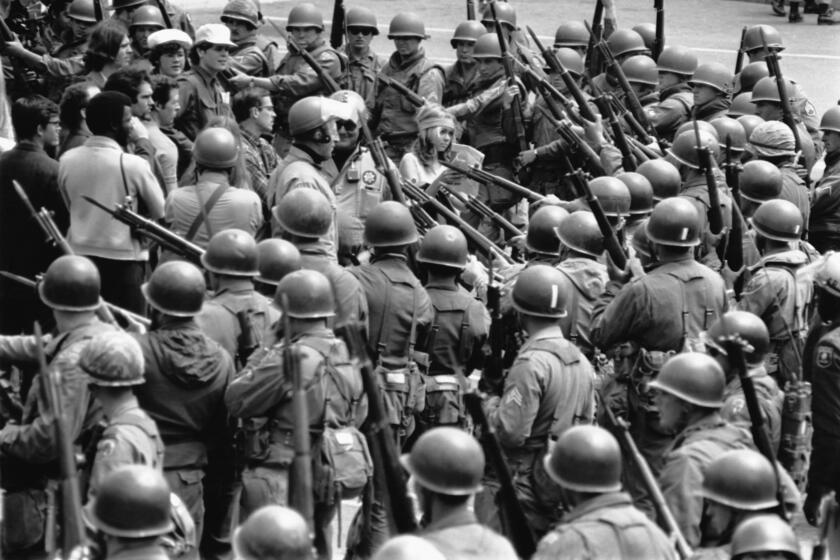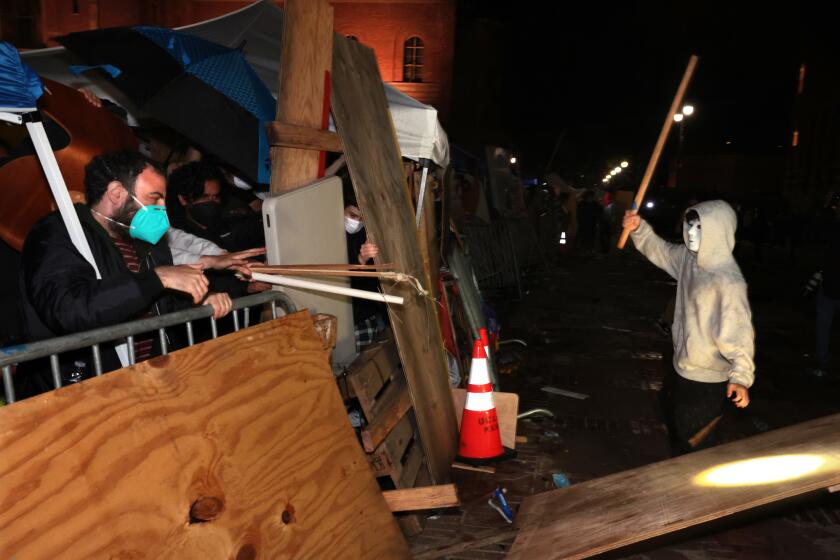Mormons’ Religion Classes Make School Prayer a Low Priority : Education: Church officials, parents favor private study system that enrolls 342,000 youths nationwide. Many attend pre-dawn sessions.
Crawling out of bed at an ungodly hour every weekday, 25,000 California youths make their way to Mormon churches in the pre-dawn darkness to attend classes on faith, Scripture and prayer--before they start their regular high school days.
In Newhall, just north of Los Angeles, the one-hour religious class for two dozen students begins at 6:30 a.m. “It’s hard, but worth it,” said Jake Young of Valencia on a recent morning.
He’s lucky. In the Antelope Valley alone, there are 31 classes that start at 5:45 a.m. and another that begins at 5 a.m.
The little-known devotional study system enrolls 342,000 Mormons nationwide, and sheds some light on why the Salt Lake City-based church is generally lukewarm on proposals for prayer in public schools.
Six of every 10 Mormon teen-agers in Southern California participate in the system that the church calls “seminary.” The classes--which begin and end with prayer--are designed for students in grades nine through 12, the period when some surveys indicate children are most likely to question or drift away from their religious upbringing.
The Church of Jesus Christ of Latter-day Saints--one of the 10 biggest denominations in the country, with a U.S. membership of 4.6 million--could add clout to the calls for school prayer, just as it has supported interfaith efforts to curtail pornography and abortion.
However, for reasons that include the religious classes for high schoolers and the church’s focus on inculcating religious values at home, voluntary school prayer “is not on the top of our agenda,” said Keith Atkinson of Los Angeles, the Mormon public affairs representative for California.
In fact, the Mormon Church in 1990 urged compliance with U.S. Supreme Court rulings that have “clearly forbidden any audible prayers in public school classrooms.” Instead, the church has limited itself to backing legal moves to permit prayers at public school graduations and at civic meetings.
Though many Mormons object to school policies that limit classroom discussion of religion, they also see disadvantages to opening the legislative doors to voluntary, student-led prayers, such as envisioned by the religious equality amendment proposed by conservative Christian groups this month in Washington.
“My husband and I are not for school prayer,” said Patti King, who teaches the early-morning class in Newhall. “We don’t want to abdicate our parental responsibilities and we wouldn’t want our ideas to be forced on others.”
The problem with prayer in religiously diverse classrooms comes down to whose prayer it will be, said Steve Gilliland, a Long Beach-based regional spokesman for the Mormon Church’s high school seminary classes. “How can you avoid offending people?”
*
By contrast, the Mormon seminary system provides settings “where our youth are free to share their feelings about faith with others who would understand and not laugh,” Gilliland said.
Despite problems finding transportation between home, church and school in some parts of the region, Gilliland said that 61% of eligible Mormon girls and boys participate in the 766 seminary classes in Southern California. Enrollment is heaviest in areas where younger families dominate.
Not all Mormon seminary students have to drag themselves out of bed for classes. In states with high Mormon populations, such as Utah, Idaho and Arizona, many young people are released from school for part of the day to attend seminary classes.
But released-time programs are nonexistent or rarely possible for Mormons scattered around California. Thus, nearly 95% of the state’s seminary students must drive or get rides for the dawn classes, Gilliland said.
“To our amazement and dismay, all seven of our children (who have attended seminary so far) have preferred the 5:30 a.m. class,” Gilliland said. “They like it because they have time to freshen up back home (before school) or begin sports practice early.”
For church officials like Gilliland, the challenge is recruiting unpaid teacher volunteers to greet a classroom full of yawning students. They employ teaching aids, a lively patter and games such as “Scripture Chase”--leafing swiftly through the Bible or the Book of Mormon to find the passages corresponding to clues given by the teacher.
“Some teachers spend more time with these kids than most parents do during the week, and certainly more time than any other church person does,” Gilliland said.
As for student motivation, young men aspiring to a two-year missionary stint, which starts at age 19, find the classes good preparation, teachers say.
Some students want to improve their chances for admission to Brigham Young University. The premier church-run school is giving greater weight each year to applicants who are seminary graduates, according to BYU spokesman Brent Harker.
But many students enjoy the classes for the seminary’s stated purpose of giving religious guidance.
In the words of Janine Hansen of Valencia, she has “a better day” at public school because of teaching that “strengthens my testimony for Christ and my knowledge of the church.”
More to Read
Start your day right
Sign up for Essential California for news, features and recommendations from the L.A. Times and beyond in your inbox six days a week.
You may occasionally receive promotional content from the Los Angeles Times.






